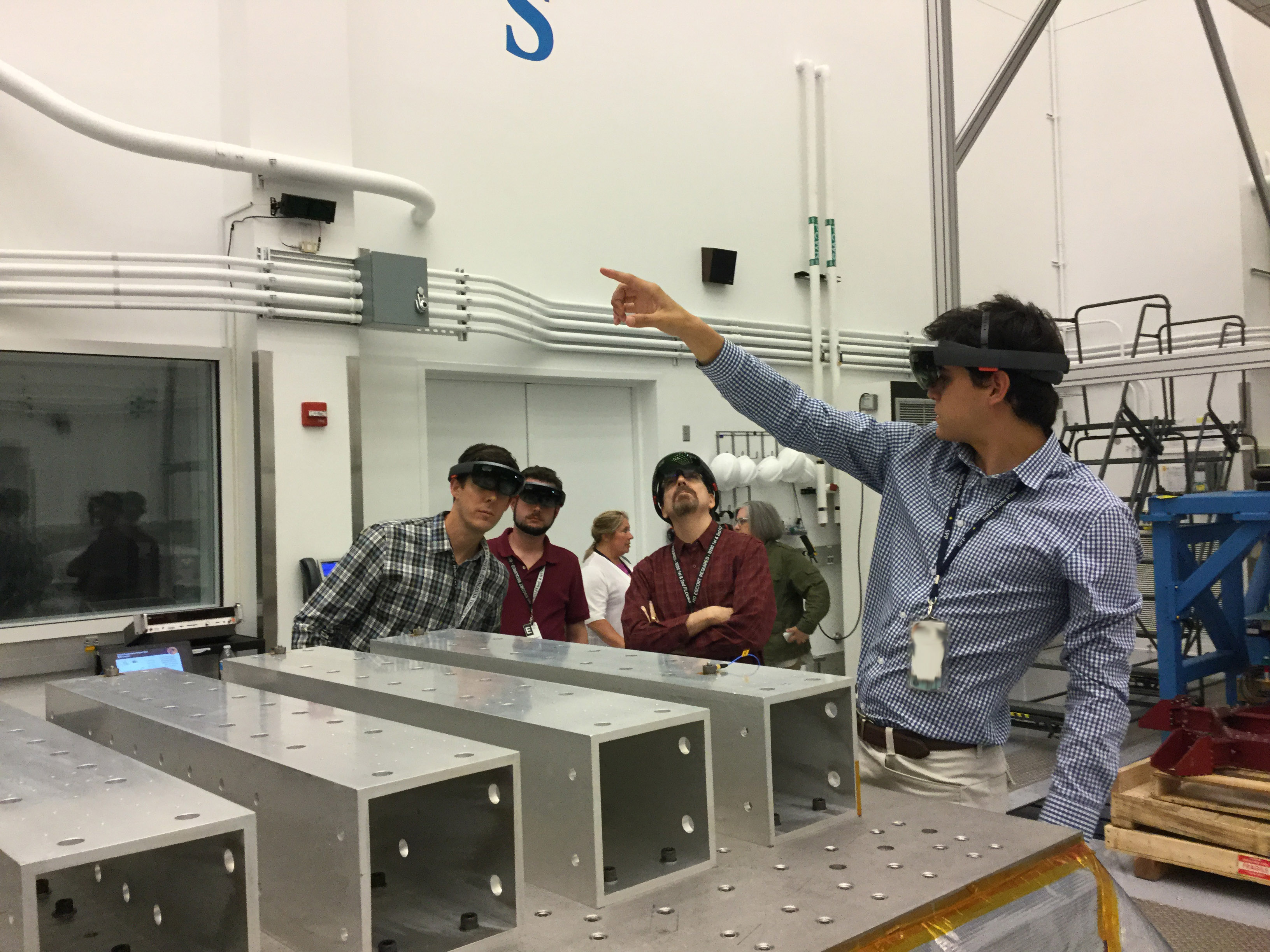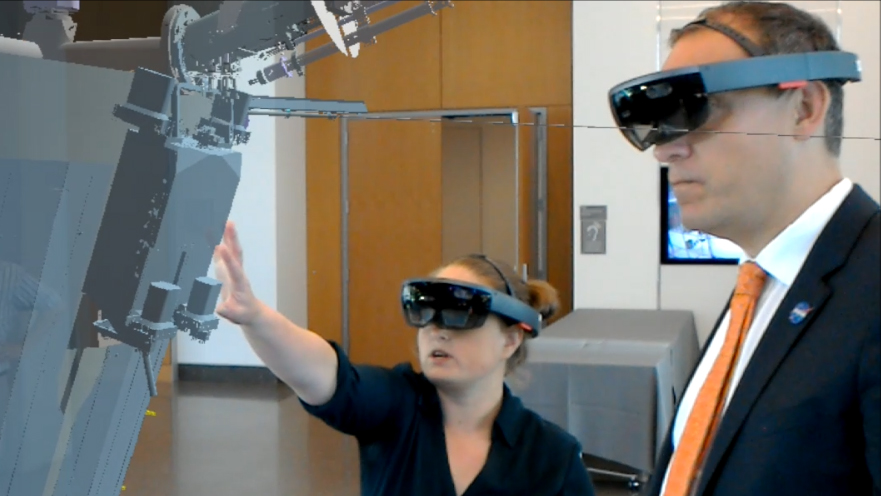Parker Solar Probe Uses An Improved “Reality” for Building Spacecraft
Posted on 2017-10-05 12:23:49New augmented reality technology developed by NASA allows the Parker Solar Probe spacecraft team to explore, rehearse, and perfect their fabrication and integration procedures—all in an immersive digital environment.
Designing and building any interplanetary spacecraft is a complex, difficult task. Designing and building NASA’s Parker Solar Probe—the first spacecraft destined to perform groundbreaking science in the harsh environment of the sun’s corona—is even more challenging due to the hazards the mission will face.
That’s why engineers from the Johns Hopkins Applied Physics Laboratory in Laurel, Maryland (where Parker Solar Probe is under construction) are leveraging a new augmented reality (AR) tool called ProtoSpace, developed at NASA’s Jet Propulsion Laboratory, to improve how the men and women building the spacecraft can work on construction in a virtual, digital space.
In early 2017, APL’s Devin Hahne, mechanical design engineer for the spacecraft’s high and low gain antennas, and other Lab researchers had proposed an augmented reality system as part of an independent research and development grant; they traveled to JPL in Pasadena, California to see ProtoSpace, a more developed version that uses Microsoft’s HoloLens AR headsets.
“We went to JPL and demonstrated our projects for each other,” said Hahne, “and there was a great collaborative aspect to the visit. We knew we wanted to use ProtoSpace on Parker Solar Probe.” Soon afterward, an agreement to use the technology on the mission was reached.
In March, JPL’s ProtoSpace team visited APL’s Laurel, Maryland campus, and performed a demo with the Parker Solar Probe team—the first ever done outside of JPL.
That’s when Felipe Ruiz, Deputy Lead Mechanical Engineer for Parker Solar Probe, became involved. During the JPL team’s visit, a demonstration of ProtoSpace with Parker Solar Probe was set up for the thermal blanket team (the blankets protect the spacecraft from extreme temperatures, and are placed in different thicknesses in different locations around the probe).
“We had six people in a conference room wearing HoloLenses and looking at the CAD design of Parker Solar Probe,” Ruiz said.
To examine one part of the bottom of the spacecraft, Ruiz “lifted” the digital model of the probe, and to get a better look, everyone laid on the floor of the meeting space.
“I looked in with APL’s Tim Cole [PSP Lead Mechanical Engineer] and there were a half-dozen people lying on the ground, wearing headsets and pointing up in the air and talking,” said Hahne.
During the very first use of ProtoSpace, the APL team determined that it would be advantageous to modify the thermal blanketing design at a specific place on the spacecraft. “In the past, this sort of work was done by sketching and laying out blankets on a low fidelity wooden model of the spacecraft,” Ruiz explained. “It worked very well, but the new capabilities we have with ProtoSpace really allow for much more collaboration and discussion, and we can visualize much more of the spacecraft design.”
Marsette “Marty” Vona of JPL, who now heads the ProtoSpace project, explains that there were several reasons the software was originally developed. “We wanted to give the International Space Station crew a way to use AR to practice evacuation procedures,” he said, “and we wanted to give teams building spacecraft a way to test procedures. The challenge in the past had been that loading spacecraft CAD [computer-aided design, 3D] models into AR was that the models are not optimized, or sometimes even unusable, in a visualization system.”
The JPL team “decided to build a tool that mechanical engineers could use themselves, and prepare their own CAD models for use in AR.”
Through a series of clever software manipulations, the ProtoSpace team created a way to employ the incredibly complex CAD models by “turning off” portions of the design that can’t be seen. By cutting back drastically on the amount of information the HoloLens had to display, speed and utility were greatly increased.
The system can support up to 10 users collaborating at one time; even larger teams are possible by using a scripted performance, akin to a PowerPoint presentation. “Those larger deployments can be used for proposals and review boards, and are extremely effective,” Vona said. ProtoSpace is relatively easy to set up and operate; Hahne brought several headsets from APL to the University of Chicago for the Parker Solar Probe renaming event in May, and guests could “tour” the spacecraft and ask NASA and APL staff members about the construction.
ProtoSpace was immediately put to work by the APL Parker Solar Probe team. One of the major recent milestones of the integration and testing of the spacecraft was the installation of the solar array cooling system. “We worked on [that integration process] for a year,” said Ruiz, “with about three or four months of that spent on developing the written procedures. We had to know the equipment and the process inside and out to get it done right. And we don’t want to begin the final installation without practice. So, we built up the model to contain the wiring and other parts we’d need, and we developed a procedure to rehearse the installation using ProtoSpace.”
At that AR rehearsal and walk-through, it was discovered that the location of a bracket would have obstructed access to a bolt that needed to be installed. “We found that the procedure needed a couple of edits, and it’s much easier to find that out three days before the installation instead of the day it happens,” said Ruiz.
During the most critical part of the actual installation, Ruiz explained that all the rehearsing made a big difference in preparedness and confidence. “I was reaching up with the others to secure the top deck [which holds the thermal protection system, or heat shield] to the spacecraft structure and I thought, ‘We’ve all been here before, in augmented reality. We talked it through. Here’s how my body placement needs to be. Here’s where I can reach. I know I can’t move much to my side at this point.’”
The final installation began at 7 am on a June morning, and Ruiz said “it went like a dream. From an overall mission perspective, it’s great to have this capability.” He added that the team is exploring adding additional procedures and processes to the construction and preparation of the probe from now until launch, not only at APL but at Kennedy Space Center in Florida and with the launch service providers. “We can take this system down and show hardware and software specifics to people who haven’t seen the spacecraft before, and we could walk through some critical events with different organizations and teams to collaborate and simplify some very complex processes. It’s great to identify and work out issues early on.”
Take an augmented reality tour with Johns Hopkins APL's Devin Hahne, mechanical design engineer for Parker Solar Probe's high and low gain antennas, as he uses the ProtoSpace tool developed by NASA Jet Propulsion Laboratory to demonstrate how installation processes for the spacecraft's high gain antenna were developed.
Credit:

ProtoSpace
Credit: NASA/JHUAPL
High-Res Image
ProtoSpace
Credit: NASA/JHUAPL
High-Res Image